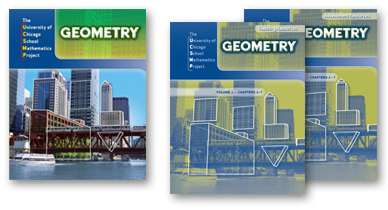[Note: I orignally reviewed the second edition of this course, but the third edition is now available. I do not expect that there are significant changes in the new edition.]
The UCSMP series probably reflects the NCTM Standards better than any other high school math series. Algebra is integrated throughout the course. Technological tools are vital to the course. Real world applications show students why they need to learn geometry. And, lessons are designed to motivate learners with different interests and abilities. As you might imagine, the result is a 900+ page text. While the text covers topics found in other geometry courses (including a brief introduction to trigonometry), it tackles them in a different sequence and, frequently, with different methods.
Students must use a scientific calculator with this course. A graphing calculator and geometric drawing programs for the computer are highly recommended—some lessons seem to rely on the use of drawing programs!
Recommended drawing programs are GeoExplorer (ScottForesman), The Geometric Supposer, Geometer's Sketchpad (Key Curriculum Press), Cabri, and Geodraw. The first three are available for both Macintosh and Windows platforms, while the last two are only for Macintosh and Windows systems respectively. (Lessons are keyed to the GeoExplorer.)
Students do learn how to do traditional constructions with compass and straight edge as well as how to use a protractor, but such constructions and drawings take a back seat to learning through study and the application of logic combined with the use of electronic tools. (Students who have used previous UCSMP texts will have already used compass and straight edge constructions.)
The course also introduces logical symbols early on and teaches two-column proofs. This is in keeping with the NCTM Standards that stress mathematical thinking and the importance of student familiarity with technology.
The teacher's edition (two volumes) suggests schedules for completing each chapter for either a "full course" or "minimal course" approach. This seems to translate into simply taking more days to finish each chapter, with a comment to the effect that slower students will not finish all chapters. However, some of the most important concepts, such as triangle similarity and properties of circles are in the last two chapters. Consequently, it seems to me that all students should complete the text, although parents might decide that there are sections within some chapters that they might skip.
Questions at the end of each section include review questions on previous lesson material. End of chapter "Progress Self-Tests" and "Chapter Reviews" cover preceding lessons within that chapter. End of chapter summaries highlight key points. Student books feature an appendix with theorems, postulates, formulas, glossary, selected answers to a few problems from each lesson, all answers to Progress Self-Tests, and answers to odd-numbered Chapter Review problems. The teacher's edition includes slightly reduced reproductions of student pages surrounded by teaching information and tips. Answers are overprinted in red on student pages. The teacher's edition is essential. An Assessment Sourcebook offers multiple forms of tests, but I suspect that most home educators will use Chapter Reviews as their primary means of assessment. The Solution Manual might be useful for more complete explanations of answers. [The website does not list any of these ancillary items.]
The course is not intended for independent study; instruction is necessary. Also, since the text was designed for classroom use, some activities are suggested for cooperative groups. Decide which of these are essential and a parent can be the other half of a "group" if necessary.
While this course is very comprehensive, that feature also means that it will be challenging to cover it all. And you might not wish to. For example, when exploring a particular characteristic of triangles, students are taught the same concept using a computer drawing program, construction tools, and drawing tools (protractor). While all of this is useful, you might not have the equipment and time to cover all three methods. Also, optional activities are suggested in the teacher's edition, and you can use discretion as to which of these to use.
My biggest concern is practicality because of the time required to figure out which parts of lessons to use as well as for lesson presentation itself. Those looking for a text reflecting the NCTM standards and who have the time to teach it properly should find this an excellent course.










